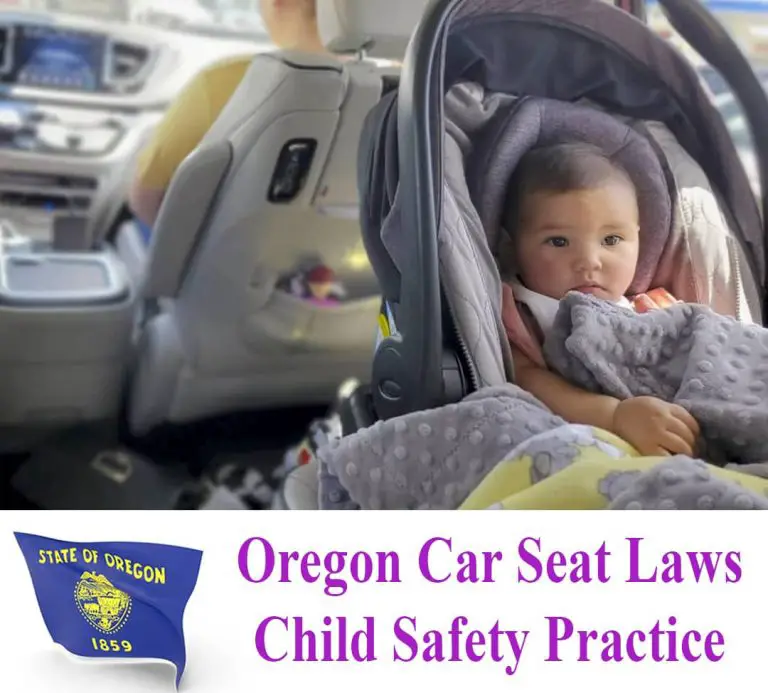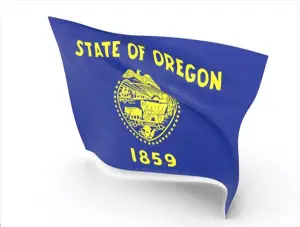Oregon Car Seat Laws - Updated & Simplified

Table of Contents
Oregon Car Seat Laws
Car Seat Laws in Oregon State (OR Statutes 811.210 to 811.225)
What do the child safety system laws in Oregon say?
- A passenger under 16 years must be properly secured with a child safety system, safety belt, or safety harness.
- Infants and toddlers under 2 years of age must be properly secured by a child safety system in a rear-facing.
- A child weighing 40 lbs. or less must be properly secured with the appropriate child safety system that meets the weight of such a child.
- A child weighing more than 40 lbs. or is 4ft 9in or less must be properly secured with a belt-positioning booster seat.
- A child measuring more than 4 feet 9 inches must be properly secured with a safety belt or harness.
- School-aged children 8 years or more, irrespective of weight or height, may not be secured with a child safety system but must be properly secured with a safety belt or safety harness.

More on the Law
- Any person who, for physical or medical reasons, may not be able to be properly secured by a child safety system is to provide a certification of exemption from the director of transportation.
- Such certificate of exemption is only issued when a signed statement from a physician, nurse practitioner, or a physician assistant stating reasons why a child safety system, safety belt, or safety harness would be impractical or harmful to such child by reason of physical condition, medical issue or body size is provided.
- The form can be gotten here under “Safety Belt Exemption Form.”
- Privately owned commercial vehicles (particularly taxicabs) are exempted from the Oregon car seat laws.
“a taxicab operator is not required to ensure a passenger is properly secured with a safety belt or safety harness.”
- A person who fails to comply with the State of Oregon car seat laws would have committed a Class D traffic violation.
- In Oregon, a Class D traffic violation attracts a fine of not less than $65 and not more than $250 for individuals and $500 for corporations. A presumptive fine of $115 is applicable. – source.
Oregon Car Seat Laws Rear Facing
The State of Oregon explicitly mentions the rear-facing car seat.
By Oregon State car seat laws, children under 2 years must be secured in a rear-facing car seat.
A child must ride rear-facing until they reach 40 lbs. weight or outgrow the weight and height limit for the car seat as set by the manufacturer.
This follows the recommendation of the American Academy of Pediatrics that says infants under 2 years should ride in a rear-facing car seat and for as long as possible (to an upper limit of 4 years).
Oregon State Car Seat Laws Forward Facing
The Oregon car seat laws do not mention the forward-facing car seat but mentions a ‘safety harness.’
On the other hand, the law also says:
A child weighing 40 lbs. or less must be properly secured with the ‘appropriate’ child safety system that meets the weight of such a child.
By this, a child who has outgrown the age limit for the rear-facing car seat is to ride in a ‘forward-facing car seat with a harness.’
By the requirements and limits of the different types of car seats, the forward-facing car seat with a harness is recommended for children who have outgrown the weight and height limit for the rear-facing car seat as set by the manufacturer. The forward-facing car seat is recommended from 4 years and can be used to a weight limit of up to 60 lbs. (depending on the car seat model).
A child is to ride in a forward-facing car seat until they outgrow the weight and height limits determined by the car seat manufacturer.
You can buy a convertible car seat which can be used in a rear-facing position and later converted to forward-facing. Here’s how to choose a convertible car seat.
Oregon Booster Seat Laws
The Oregon car seat laws on booster seat require that a child weighing more than 40 lbs. or measuring 4ft 9in or less be properly secured with a belt-positioning booster seat.
On the other hand, before transitioning to a booster seat, a child is to have outgrown the weight and height limit of the forward-facing car seat as set by the car seat manufacturer.
A child may continue to be secured in a booster seat until the vehicle lap and shoulder belt can fit properly on such a child.
Oregon Seat Belt Laws
The State of Oregon permits a child to start using a seat belt once they reach 4 feet 9 inches in height.
However, according to the State of Oregon, you are advised to confirm the following if you have doubts that your child may not be fit to use the vehicle seat belt;
“Until you can answer YES to all of the following questions, your child should ride in a booster seat:
- “Can the child sit all the way back against the vehicle seat?”
- “Do the child’s knees bend comfortably at the edge of the seat?”
- “Does the shoulder belt cross the shoulder between the neck and arm?”
- “Is the lap belt as low as possible, touching the thighs?”
- “Can the child stay comfortably seated with the fastened seat belt for the whole trip?””
Usually, a child would have grown big enough for the seat belt to fit properly between 8 and 12 years.

Other Car Seat Laws You Need to Know About in Oregon
Car Seat Laws for Other Passengers in a Car
All vehicle occupants, including the driver, must use a seat belt.
Oregon Car Seat Laws Front Seat – Can A Child Sit in The Front Seat?
Oregon car seat laws do not mention either the front or back seat for a child safety system.
However, the State of Oregon recommends following national best practices recommendations from the National Highway Traffic Safety Administration in its laws.
By general best practice, a child under 13 years is not to ride in the front seat. A child under 13 years is to ride in the back seat with the seat belt fastened correctly or in a child restraint system.
While on the other hand, a rear-facing infant seat should NEVER be installed in the front passenger seat with an activated airbag.
Also, the center rear seat is the safest location (double-check the URL) in a vehicle to install a car seat.
Oregon Car Seat Laws for Ubers, Taxis, or Cabs
The Oregon car seat laws exempt ‘privately owned commercial vehicles,’ particularly taxicabs.
“a taxicab operator is not required to ensure a passenger is properly secured with a safety belt or safety harness.”
However, your child’s safety is your responsibility as a parent. Therefore, you should ensure to follow the safe practice of securing your child with a child safety system.
When boarding a taxi or Uber, you may need to install your infant car seat without the base. This guide will help you install a child car seat without the base.
Can You Leave a Child in the Vehicle Alone in Oregon?
The State of Oregon does not practice the ‘hot-car’ law or have any law that prohibits leaving a child unattended in a vehicle.
However, it is not a safe practice. Leaving a child in a car unsupervised is not a recommended thing to do.
A car could get hot in minutes, leading to hyperthermia, an abnormally high body temperature.
A child could also start playing around and touch anything that could make the car start moving.
Therefore, ensure not to leave your child alone in the vehicle.
Smoking Around Children in a Car in Oregon – is it illegal?
Smoking around a child under 18 years in a motor vehicle in Oregon is illegal and is an offense that falls under Class D traffic violation for a first-time offense and Class C traffic violation for a second or subsequent offense.
- In Oregon, a Class D traffic violation attracts a fine of not less than $65 and not more than $250 for individuals and $500 for corporations. A presumptive fine of $115 is applicable. – source.
- In Oregon, a Class C traffic violation attracts a fine of not less than $85 and not more than $500 for individuals and $1,000 for corporations. A presumptive fine of $165 is applicable. – source.
This is what you need to understand about smoking around a child and why it is unhealthy for them;
Secondhand smoke is not safe for a child’s health. It exposes them to many health risks, including severe asthma attacks, bronchitis, pneumonia, respiratory infections, ear infections, and sudden infant death syndrome (SIDS).
As a parent, you are responsible for your child’s health, therefore, you should not smoke when around them.

